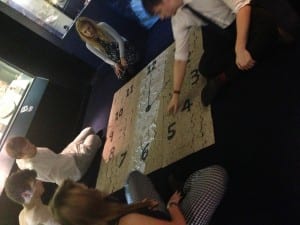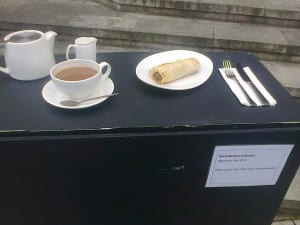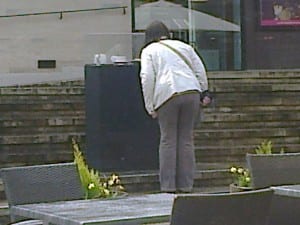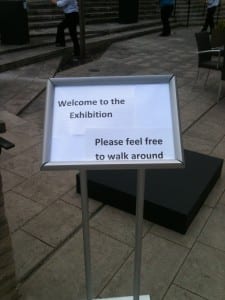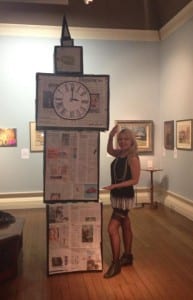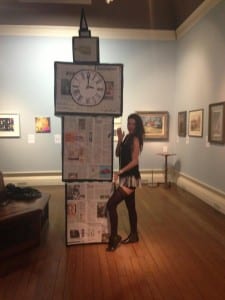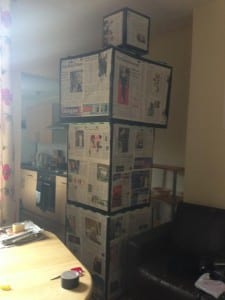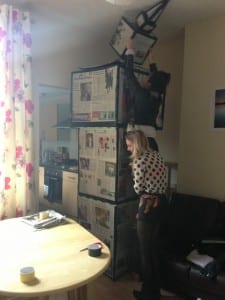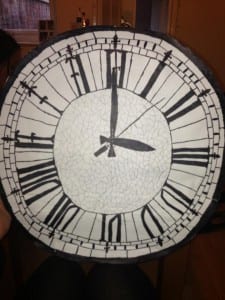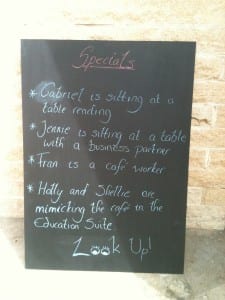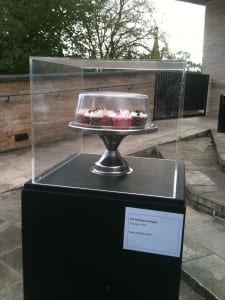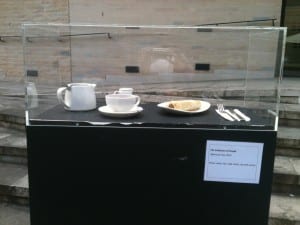Possessed Time in Action
Beginning with an hour of ‘sleep’ our Site Specific Performance was underway. The daunting thought of doing a five and a half hour performance was quickly forgotten as we started the strenuous movements that represented getting ready for the compressed day ahead. When practising this had always been difficult for the group as our arms were not trained for the repetitive controlled movements. This was the first time we had done all three actions together for the full amount of time, and I thought that this would be difficult, having to keep up the precise controlled movement, yet each segment became increasingly easier.
Next was the walking routine where we walked alongside the ticking noise of the clock. We had played with and experimented a lot with this section but decided on a simple movement to show the routine of the act and the control time had over us. Despite this the track we used on the actual day was a lot shorter than the one we had practise with and because it had to repeat itself there was a break in the rhythm, potentially throwing the synchronization. It could have looked messy if we started to walk at our own pace but instead if anyone in the group lost confidence in the rhythm, they would stop for a beat and then join in again, which kept the section looking crisp.
As soon as we sat down to start the puzzle we all seemed to speed up and move as fast as we could. This shows the effect of being controlled by a mechanic rhythmic movement and then being able to break out of that strict discipline. Due to this we completed the puzzle, the first time, very quickly but as time went on, the puzzle became increasingly difficult. This may have been due to fatigue, but mainly to do with the pieces not sitting as true as they did at the beginning. This made it harder to put them together and to judge if pieces fitted where we were putting them. Luckily we finished the puzzle for the final time just before we changed discipline so we smartened it up for the proceeding audience members.
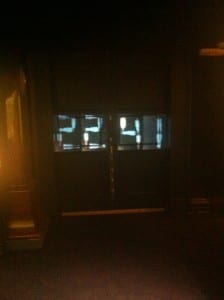
After the walk home came the watching of the human clock, which we had projected on the gallery’s door. In my opinion this proved the most difficult as we were sitting on the floor looking up at the projection in a set position, which quickly became uncomfortable. Furthermore because this part contained very little movement this section seemed to last longer than it actually did. After the four and a half hour mark we had our dinner eating representation, which we did to the rhythm of the clock again showing its control and also the robotic routine of this part of the day. Fatigue was definitely an issue here as the movement became a lot harder than the ones from earlier. In addition to this we were sat in a similar position to the clock watching, which made it even more uncomfortable.
When we entered our second stint of sleeping the museum had become busier and other performances had now finished. This meant that a lot more people were about. Feeling them walk about the room was a weird experience because when you are asleep you feel safe and in comfort, but when you feel people are around and watching you, it makes it a lot harder to relax and in turn you feel uncomfortable. In addition to this, a weird sense of blinking with my eyes closed came over me as the projection of the pineapple was directed straight at our faces. The flicking of the images made feel like I was blinking and this became really uncomfortable for me, so much so I had to cover my eyes from it.
The Effects of Possessed Time
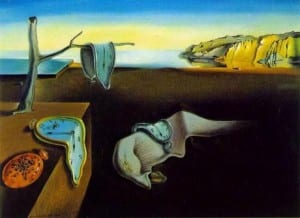
The Persistence of Memory by Salvador Dalí, found on: http://psychopathyawareness.wordpress.com/2011/06/15/why-do-sociopaths-waste-our-time/clock-melting-clocks/
Being on a Saturday the Usher was always going to be busier than most of the days we had practise but because we had experience a busy day before, it was not as daunting or distracting.
After we woke from our first section of sleeping it was encouraging to see so many people watching and several were sitting down which showed they were interested to stay for a good amount of time. As we then continued towards the glass cabinets I felt the audience then become uncomfortable and they started to usher themselves towards the door, although the fact they were still watching was good as it showed they were interested. The public still seemed intrigued and as we had experienced in rehearsal, after one member of the audience decides to get closer and have a better look, then the rest follow. Obviously for most this is not what they expected when they came to the museum but the fact they continued their day and embraced what we were doing was exciting.
When we started to walk around as expected the audience backed away into the corner by the gallery’s entrance. The audience seemed to be impressed and fascinated by this movement as there was a lot of people here at this point. During this section there was a group of ladies that had walked in. As I was just in my underwear they were shocked and had to turn away in embarrassment as my path led straight to them, this was interesting because the rest of the audience did not appear to see it as nothing else than a costume like the rest of my group. When we sat down to start the puzzle more people filtered in around us. In the past when we had done we had felt that people wanted to join in, or at least the engagement of the puzzle made them want to stay around until it had been finished.
As we sat down to watch the human clock observing the audience became a lot easier. We had now drawn attention solely towards it and because we were essentially staring at the entrance the audience reactions were clearer. Several people came and stood at the entrance and watched the clock for several minutes with us. This could have been down to their sense of intrigue towards the clock or maybe because our piece was so elongated they were wondering why we were watching it for so long. Furthermore during this section a lot of parents with their children became engulfed by what we were doing. It even became fairly interactive as parents were asking their children questions on what we were doing and what they thought of the different projections.
On top of this the puzzle was continuously acknowledged and seemed to impress. Now the distorted projection of the pineapple could be seen clearer as there was now little distraction. For a long time no one had dared stepped into the gallery, which was not disappointing but it would have given the piece another dynamic. This was until one man decided to walk straight through us to the other side of the gallery and acted totally vacant towards our existence. This was interesting because it felt like he was trying to make the point that we should not have been there.
Overall, I feel that the public enjoyed our piece and welcomed a different aspect in their museum experience. What I found the most interesting was the willingness of people to continuously come back over the period of the day, almost as if they were checking on our progress, which is what we intended as we never expected anyone to stay for the whole duration of the piece.
Authored by Shane Humberstone
